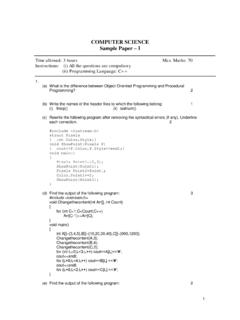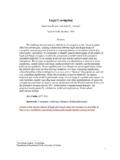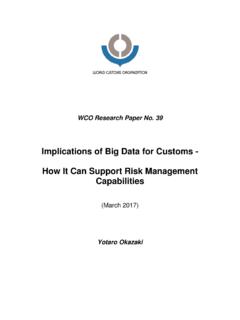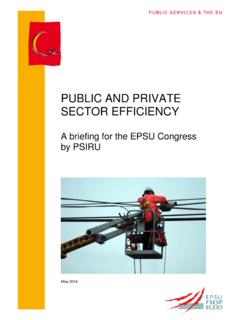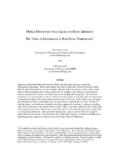Transcription of Going Public—Microsoft, 1986 - AABRI Home Page
1 Journal of Case Research in Business and Economics Going public microsoft , 1986. Hassan Shirvani University of St. Thomas Barry Wilbratte University of St. Thomas Abstract The case takes the reader through the IPO process using the microsoft 1986 public offering as an illustration. It reveals the motivations of the corporate participants and investment bankers, the interaction between the market and firm's fundamentals, and the negotiation process in setting the offer price. It begins with microsoft executives' internal discussion and reasons for considering an IPO, continues with the process of selecting underwriters, and goes on to trace the events of the road show process.
2 Ultimately, it reveals how the final offer price and the underwriting fees were negotiated. Keywords: offer price, syndicate, prospectus, road show, institutional investor, the book Going public , Page 1. Journal of Case Research in Business and Economics Introduction On March 13, 1986, microsoft had a highly successful initial public offering (IPO) at an offer price of $21. By the end of the day, the stock price had risen to $ , and Bill Gates made the headlines as the wealthy owner of 45 percent of the corporation's stock. The actual public offering occurred at the end of an arduous 5-month process during which underwriters were selected, numerous legal and regulatory issues were hammered out, potential investors were courted, and the expected terms of the offering changed dramatically.
3 At various points during the process, the expected offer price varied from $15, to a range of $16-$19 suggested by Bill Gates even as the underwriters were suggesting $17-$20, to a range of $20-$22. More than most firms, microsoft took a hands-on approach to the IPO process rather than deferring to Wall Street underwriters to the extent most firms do. (Fortune, 1986). Founded in 1975, microsoft was in 1986 the oldest major producer of software for personal computers, its largest products being the nonmenu driven PC-DOS and MS-DOS. operating systems, which ran the operating systems of the IBM computers and clones. microsoft also sold applications programs such as spreadsheets and word processing software for IBM and Apple personal computers.
4 It is noteworthy that these packages gave the company a broader product line than some of its competitors. In addition, the firm was somewhat late in offering its stock publicly as compared with other software companies. The relative lateness of microsoft 's IPO derived in part from the desire of Bill Gates to maintain control and the fact that microsoft was not dominated by venture capitalists eager to harvest their gains (only one venture capitalist, with a percent share of the company). In addition, microsoft had no real need for capital, with pretax profits running as high as 34 percent of revenues (Fortune, 1986). However, Gates had been selling shares and granting stock options to talented managers and cutting-edge programmers, and projections indicated that by 1987, the firm would have over 500.
5 Shareholders, so microsoft would have to register with the SEC. Once registered, the firm would be for all practical purposes publicly traded but would have a very narrow market. So in fall 1985, Gates reluctantly agreed in an internal corporate meeting to go public in order to gain broader ownership, but reserved the right to back out of the decision at any time before the stockholders' meeting of October, 1985. (Fortune, 1986). The Decision to Go public At the October stockholders' meeting, Gates made the commitment to begin the IPO. process. The chief financial officer (CFO) accepted the task of finding underwriters to handle the IPO. Finding an underwriter was easy, since investment bankers had been courting him heavily, the smell of hefty fees in the air.
6 He decided that he would select a first rank firm as the lead underwriter, with a boutique firm to co-manage the offering, thus enhancing microsoft 's appeal to investors with a specific interest in technology stocks. Some of the larger firms such as Merrill Lynch and Shearson Lehman were immediately ruled out, as they had too little experience with technology firms. Eventually, the participants put together a syndicate, a group of investment bankers sharing the risk of underwriting this huge stock offering, which finally came to number 114 firms (Fortune, 1986). Beginning with a small group of possible firms to serve as lead underwriters and to co-manage the offering, microsoft narrowed the field to two, Goldman Sachs and Alex.
7 Brown, neither of which had yet taken the step of Going public Going public , Page 2. Journal of Case Research in Business and Economics themselves, although Brown was preparing to do so. (Forbes, 1986) The original pool of candidates was selected systematically, and it was understood that any of these firms had the technical capability to carry the deal to completion. Ultimately, the final choices came down to personal chemistry how well their representative got along with Gates, the CFO, and the rest of the Micro team. The following quote indicates how subjective the decisions were: Following an expensive dinner with Goldman Sachs, Gates said, Well, they didn't spill their food, and they seemed like nice guys.
8 Similar judgments were rendered regarding Alex. Brown. microsoft 's board accepted this logic and quickly approved Goldman and Brown. (Fortune, 1986). Preparation for the public Offering On December 17, the offering got under way with a huge formal meeting at microsoft headquarters, involving microsoft 's managers, its auditors, both managing underwriters, and their attorneys always, the lawyers. A high priority for microsoft was making its preliminary prospectus, or red herring, jury proof. This term means that the prospectus is so carefully phrased that no investor could sue based on the claim that s/he was misled. The task was to make the preliminary version of the prospectus conservative enough that the SEC would not require heavy revisions while also avoiding making it so conservative that it failed to attract investors.
9 During the promotional period, microsoft would be limited to touting the stock based solely on information in the prospectus, as any claims made that were not covered by the prospectus could be grounds for a lawsuit. The attorneys spent weeks working on this document, and then the principals to the IPO met again to discuss its content. They discussed scenario upon scenario regarding what could go right or wrong. It was not until February 3 of the following year that copies of the final prospectus were sent to the regulators and the waiting process for the review by the SEC began. (Fortune, 1986). As for the stock's offer price, microsoft 's expectation at this point was that it would sell the shares for $15.
10 This offer price was intended to land microsoft 's PE ratio near the midrange of the PE ratios of other firms with recent IPOs higher than those of that of Lotus Development Corporation and Ashton-Tate, which had narrower product lines than microsoft , but lower than those of companies that create software for mainframes because they generally had longer track records and more stable earnings than microsoft . Gates imposed an informal rule that no one should sell more than 10 percent of stock holdings a total of 600,000 shares, compared with the company's expected sale of 2,000,000 shares. (Fortune, 1986). By late January, the question of what stock price to expect had evolved a bit.











